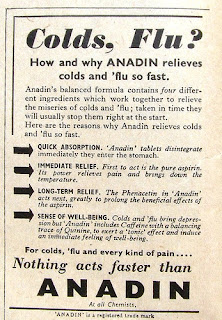Behaviour Change
PROPAGANDA FOR CHANGE is a project created by the students of Behaviour Change (ps359) and Professor Thomas Hills @thomhills at the Psychology Department of the University of Warwick. This work was supported by funding from Warwick's Institute for Advanced Teaching and Learning.
Thursday, January 31, 2013
Anadin- nothing acts faster?
These are two of Anadin's ads. Anadin is a pain reliever sold in the UK and Ireland. There are several different types of Anadin, all containing either paracetamol, ibubrofen and/or aspirin.
The tagline "Nothing acts faster" is a misleading one. While it is true that nothing acts faster, the tagline implies that Anadin is the fastest. All pain relievers that use the same ingredients have the same speed of action. This is an example of misleading inference. It puts Anadin in a more favourable light compared to other similar brands.
The message is persuasive for two reasons. Some message receivers are likely to take the peripheral route to attitude change as choosing a pain killer brand is of low personal relevance. Other message receivers might take the central route to attitude change as the ads provide detailed arguments as to why Anadin is so good. The best of ads make use of both routes.
The second reason why the ad is persuasive is due to the misleading inference. In one study, researchers had participants in three ad claim conditions were they were exposed to the same advertisement, bar a small difference. In the strong marketing leading condition, participants read “In 2002 (over the last five years),
doctors prescribed PRIDON more than any other brand of prescription pain reliever".In the moderate condition, the time length was changed to 6 months. In the control condition, the simply read “Prescription
medicine for the treatment of severe pain.” Participants then had to rate how effective they thought the painkiller was on its own and compared to other pain killers and how much they thought doctors would prefer it. The scores on all 3 dependent measures were higher for the strong ad claim condition (Mitra, Swasy, Aikin, 2006).
Mitra, A., Swasy, J., & Aikin, K. (2006). How Do Consumers Interpret Market Leadership Claims in Direct-to-Consumer Advertising of Prescription Drugs? Advances in Consumer Research, 33, 381-388.
Subscribe to:
Post Comments (Atom)



Nice description.
ReplyDelete